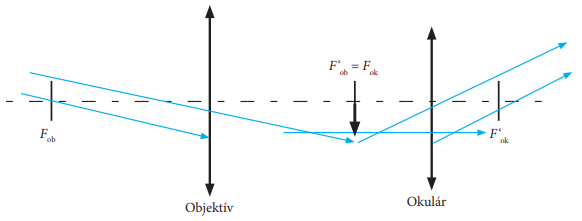Practical Exercise 1: CONSTRUCTION OF RAY COURSE
If pupils in the eighth or ninth grade (according to the specific school educational programme) have studied the course of rays through a lens and significant rays, it is possible to construct the model of the course of rays through Kepler telescope, which is suitable also in case it is followed by Practical Exercise 2 (construction of a simple Kepler-type telescope). In any case, it is appropriate to repeat the basic elements of an optical system (optical axis, image and focal point of a converging lens) and significant rays for the construction of the image displayed by a lens:
Ray no. 1 passes parallel to the optical axis and, after passing through the lens refracts into the image point of the lens (F’).
Ray no. 2 passes through the focal point (F) and, after passing through the lens refracts parallel to the optical axis.
Ray no. 3 passes through the centre of the lens and does not refract after passing.

Figure 2: Significant rays when the image is formed by a converging lens
After this exercise, it is possible to proceed with the construction of ray course with Kepler telescope. Here it should be mentioned to pupils that the objective lens in the simplest case consists of one connecting lens with a large diameter and a larger focal length than the ocular lens, as can be seen in the Figure:

Figure 3: Ray course in Kepler telescope
Rays entering the telescope can be considered parallel, because they enter the telescope from a great distance (in optics, mere five metres is almost infinity...) and at a very small angle with respect to the optical axis - one of the reasons for using a telescope is to increase the visual angle at which we see the observed object.
A true image of the observed object penetrates in the image point of the objective lens F‘ob on the structure with the use of significant rays. We then observe it through the ocular lens like with a magnifying glass. From the construction of the image by means of significant rays, it is clear that the rays emerging from the telescope form a greater angle with the optical axis than the rays entering it. It can also be seen that the rays which enter from top left downwards emerge from bottom to top. It means that Kepler telescope inverts the image.


